Five Training Lessons you MUST Teach Your Dog
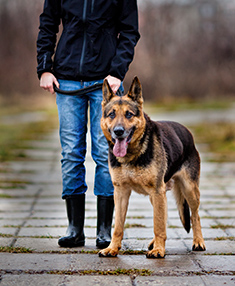
Bringing a new dog into your home is a challenging affair that demands careful consideration. It’s not enough to simply walk the dog through the front door and hope he will acclimate to his new surroundings; you have to teach him how to interact with the new people and items in his environment.
One of the most effective methods for starting a new dog on the path to success is teaching him the “Big Five,” the five most common and most important commands in basic training.
Your dog won’t win any obedience competitions, but with a firm grasp on sit, stay, down, come and leave it, he’ll be more reliable in the way he behaves from day to day. Teaching the Big Five is relatively simple and requires only a few minutes each day.
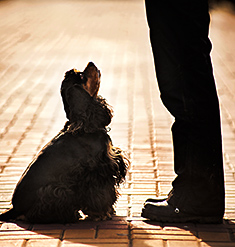
Sit
Sit is the most basic command available to dogs, and it is rare to meet a dog that hasn’t figured it out one way or another. If your dog doesn’t know how to sit, take a bite-sized treat and wave it in front of his nose.
Once he realized you have something tasty, he should focus his attention on the delectable goodie in your hand. Slowly raise the treat up and back over his head, forcing him to look straight up to follow the course of your hand. As his head comes up to follow the treat, he will naturally sit down. Reward him with a treat and try it again.
Don’t say the word “Sit” until you can reliably make your dog sit down. Once he sits every time, start saying “Sit” as soon as his butt hits the ground. This pairs the verbal command to the specific action of sitting.
You can ask your dog to sit before eating his daily meal or before entering or leaving the house. Sitting forces your dog to wait and prevents him from lunging out the door or knocking a food or water bowl out of your hands.
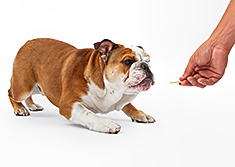
Down
Once your dog has an idea of how to sit, you can start working on the down command. Downs are very useful when your dog is being rambunctious or you need him to leave you alone for a few minutes while you finish up some work or enjoy a meal.
You can teach downs in the same manner you taught the sit command – leading. Hold a treat in front of your dog until you have his attention. Lower the treat straight down towards the ground and allow your dog to follow it with his nose.
Most dogs will naturally lie down as they complete this action. If your dog gets up and walks towards you or tries to snag the treat, start over from the sitting position.
Just like the sit command, you can start saying the word “Down” when you can reliably make your dog lie on the ground. Do not repeat the command, and do not use it before you can reproduce the behavior.
Small dogs often show a reluctance to lie down, but with a little patience, you should be able to get the results you want with the same course of action. If not, reward your dog whenever you catch him laying down and say the word “Down” to associate the position with the word. It takes longer, but will eventually build the connection in your dog’s mind.
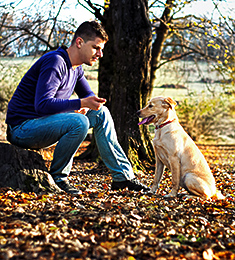
Stay
Stay is a little trickier to teach, though it is usually the enthusiasm of the human that ruins the trick more than the desires of the dog. Place your dog in a down or sit position and say the word “Stay.”
It is important that you do not look away, walk away or turn your back to the animal. Count to five in your head, reward the dog with a small treat and then release him by saying “Release” or “Finished.” You must pair the stay command with a release, otherwise your poor pup will not know what exactly he’s waiting for. If the dog breaks, simply walk him back into position and try again.
Remember that training a stay involves using the three “D’s” – duration, distance and distraction. Work with duration first; if your dog cannot stay for 30 seconds with you standing over him, he certainly can’t stay that long with you walking away.
Start with duration, add distance once duration is solid and add distractions when you feel your dog is ready. Every time your dog breaks a stay it means you pushed him a bit farther than he was prepared to go; walk him back and remove one of the elements from that stay to encourage success. You can only reward your dog for successful stays.
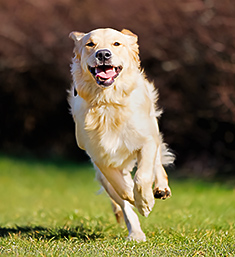
Come
Ask about the background of the staff that will be working with your dog. Have they been background checked to make sure they don’t have any animal cruelty charges in their past? Also, you should be aware that several other crimes including domestic violence are associated with animal cruelty and should be a red flag.
Come is one of the most important skills your dog will learn, and one of the most formal of commands. This command, also known as a recall, can save your dog’s life. The come command also keeps your dog away from people that may not want to interact with him and gives you a way to retrieve him when it’s time to leave the park or pack up for a road trip.
Teaching the come command is actually quite easy, but most dog owners go about it in the wrong way. To teach your dog this skill, all you need to do is reward him whenever he comes over to you. If you spend your time shouting at your dog or calling him while he’s not paying attention, you’re simply breaking the command and lessening the value of the verbal cue.
Bring some treats with you to the dog park and give your dog a small bite every time he takes a break from playing to return to you. When you see him coming towards you, say “Come” one time.
The idea is simple – teach your dog that coming to you is always going to turn out awesome. When you are in the house, keep treats nearby and toss one to your furry friend whenever he happens to come by.
If you don’t think your dog will come when you call him, skip calling him and retrieve him yourself. If you save the “Come” command for successful recalls, your dog will build an impressive habit of coming to you whenever he hears your call. Think about it like this – if someone gave you five dollars every time you walked up to them, you’d be much more likely to come when they asked you to.
Leave It
Leave it is another command that can save your dog’s life. Chocolate, aspirin, dead birds and pretty much anything else your dog happens to find on the ground can pose a serious health risk if ingested, and it is important to teach your dog to leave things alone.
Do note that “Leave it” and “Drop it” are different commands – “Drop it” means “Drop that for now” while “Leave it” means “Never touch that again.” Dogs with a powerful “Leave it” will spit food out on command, which is far preferable to digging an old hamburger out of your pup’s mouth.
To teach leave it, place a large piece of sausage or treat on the floor and cover it with your hand. Your dog will likely lick, sniff and paw at your hand to try to retrieve it; just wait patiently while this happens.
When your dog looks away from the treat (usually up at you to say “I don’t get it!”), say, “Leave it” and reward with a different kind of treat from your other hand. Because “Leave it” is permanent, your dog should never receive the piece of meat you’re covering.
Once your dog gets the idea, you can remove your hand and encourage your dog to ignore the treat on his own. If he snatches it up, you’ll need to take it out of his mouth and try again. Your dog should learn that when you say “Leave it,” it does not mean “Leave it unless you’re faster than me.” It means, “Leave it or I’m going to take it from you.”
The Big Five serve as the foundation for any dog’s training regimen. A dog that can’t sit, stay, or lie down won’t find it very easy to learn more complex tricks like crawling, rolling over or begging.
The Big Five also provide you with a simple set of commands that you can use to make your life with your dog easier. With a firm grip on these five commands, your dog will be more predictable, manageable, and fun to be around. It’s also not a bad way to show off for friends and family, depending on how much work you put into each.
Doggies Den: Latest Articles
 Homemade Thanksgiving Treats for Your Dog
Homemade Thanksgiving Treats for Your Dog
NUTRITION We all want to include our dogs in our holiday celebrations, but hopefully, you're aware that sharing table scraps with your dog isn't always the best idea.
 Keeping Your Dog Safe during the Summer Months
Keeping Your Dog Safe during the Summer Months
HEALTH Summer is coming on fast, so it’s time to plan how you will keep your dog safe and healthy through the lazy, carefree, warm days.
 Vaccination Time Again-Keeping Your Puppy Healthy
Vaccination Time Again-Keeping Your Puppy Healthy
DOG HEALTH So you have your new puppy picked out. There are quite a few shots, treatments and examinations that will keep the newest member of your family healthy.
 Canine Thanksgiving Feast
Canine Thanksgiving Feast
NUTRITION With the wide variety of food at Thanksgiving dinner, chances are you'll want to give your dog something special, too. If you're contemplating what to feed your dog for the holiday, here is a guide to a great Canine Thanksgiving Feast.
 Dog Walking Tips Every Owner Should Know
Dog Walking Tips Every Owner Should Know
DOG FUN Walking your dog is not only crucial to keeping him healthy and happy, it strengthens the bond between your canine friend and his caregiver. There are a lot of obstacles out there. Don’t forget these simple tips to keep your walk fun and safe in the outside world.
 The Benefits of Physiotherapy for your Dog
The Benefits of Physiotherapy for your Dog
HEALTH The same techniques that physiotherapists use to treat a variety of injuries and conditions in humans have been adapted to suit animals with great success. Family pets, show dogs, and working dogs can all benefit greatly from physiotherapy. Dogs whose activities involve a lot of agility are especially susceptible to the types of problems that physiotherapy can address.
 The Decision- Adding a Dog to Your Family
The Decision- Adding a Dog to Your Family
FIRST TIME OWNERSBringing a dog into your family is a decision where many people don’t realize it’s magnitude until after they have the dog. There are a number of things that you need to research before you decide to purchase a dog, and it starts right in your own home.
 Bringing Your Dog Into Your New Baby's Life
Bringing Your Dog Into Your New Baby's Life
HEALTH Many believe that a dog and a new baby cannot happily coexist, so therefore the dog has to go. This is not necessarily the case.  A new baby does not mean you have to abandon your dog.

Doggies Den:
Most Popular Articles

Dog Pregnancy Symptoms
HEALTHIf you suspect your dog might be pregnant, check out part one in this series on pregnant dogs, where we cover pregnant dog symptoms.

Dog Birth
HEALTHIn the third article of our dog pregnancy series, we look at the wonderful, but messy, process of bringing newborn puppies into the world.

Indoor Dog Potties
DOG PRODUCTSIt's been a long day at work. You were so busy, you didn't even take time to eat a sandwich, let alone run home to let your dog out. You're on your way home, knowing the poor dog is crossing his or her legs by now, when your car breaks down, delaying you even further. Can't somebody make this easier?

Your Dog’s Digestive System
PHYSIOLOGYEver wonder why your dog eats so fast? Or why he eats gross things? Or why he gets sick to his stomach? Or why his waste stinks so bad? Some of these things are normal, some are not.

Canine Respiratory System
BREATHINGThe basic function of your dog's respiratory system is to bring oxygen in to and remove carbon dioxide from the body. Knowing the symptoms of respiratory diseases can help you help your stay healthy.

Shelter Dog Adoption Tips for Success
ADOPTION Are you intimidated by the prospect of "rescuing" a dog from a shelter? One reason that you may be wary of adopting a dog from a shelter is not knowing how to choose. Adopting a dog from a shelter can be a rewarding process, if you're prepared to do a reasonable amount of research.

Canine Urinary Tract Infections
SYMPTOMS AND TREATMENTDoes your dog seem to be having trouble relieving his or her bladder? Learn how to recognize the signs of urinary tract infections and how to treat them before they spread.

What to do for Dog Diarrhea
SYMPTOMS AND REMEDIESIf you have dogs in your house for any length of time, you have likely experienced at least one bout of dog diarrhea. Beyond the pain in the tuckus involved in cleaning up the mess, you should know what causes diarrhea, and when it's important to see the vet.

What to do for a Dog Bite
DOG BEHAVIOR Getting bitten by a dog can be scary, and you may be tempted to run around in circles for a while, trying to figure out what to do. Here's our guide to help you manage the situation.

Top Ten Tips for Living with a Senior Dog
DOG HEALTH Bringing home a new puppy is so exciting, but it doesn’t take all that long for your exuberant puppy to grow into a senior dog who may have special needs. Here are the doggies.com top ten tips for taking care of your companion who has been with you through so much.
